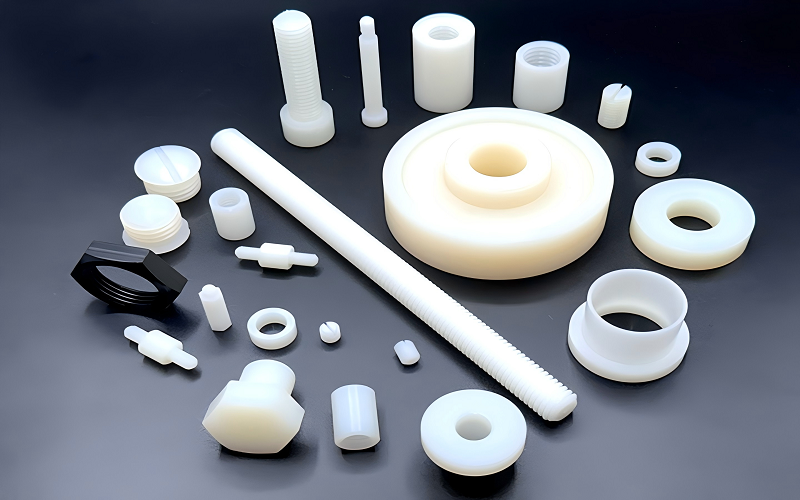You can meet nylon every day, whether in your clothes, in your kitchen tools, or even in your children’s toys.
Since nylon has applications in many areas, it is natural that one begins to ask, “Is nylon safe?”
In the following sections, we will briefly discuss the composition of nylon, its effects on health and the environment, as well as some relevant regulations to help you better understand the safety of nylon and whether it is suitable for everyday use.
What Is Nylon?
Nylon, also known as polyamide (PA), is a material synthesized through chemical reactions. It was invented by DuPont in the United States in the 1930s. Because nylon is strong, not easy to wear, and can resist corrosion from chemicals, it was quickly widely used in many industries.

Types of Nylon
The most common types of nylon are Nylon 6 and Nylon 66, which differ slightly in their chemical structure but are used in similar applications.
Nylon 6, for example, is often found in textiles and automotive parts, while Nylon 66 is frequently used in fibers and films.
Other less common types include Nylon 11 and Nylon 12, which are used in more specialized industries, such as aerospace and electronics.
Nylon’s versatility stems from the way it is created—through polymerization, where small molecules (monomers) are combined to form long, repeating chains of polymers.
Each type of nylon has its own strengths and weaknesses, and understanding them helps when evaluating its safety.
The table below describes the different types of nylon and their applications for your reference:
| Nylon Type | Melting Point (°C) | Properties | Applications |
| Nylon 6 | 220 | High toughness, good fatigue resistance, easy to process. | Textiles, automotive components, industrial parts. |
| Nylon 66 | 265 | Higher melting point, greater strength and stiffness than PA6. | Automotive parts, electrical connectors, industrial equipment. |
| Nylon 11 | 185 | Biobased, good flexibility, and chemical resistance. | Flexible tubing, fuel lines, industrial films. |
| Nylon 12 | 178 | Low moisture absorption, excellent dimensional stability. | Electrical insulation, automotive tubing, packaging films. |
| Nylon 610 | 220 | Good toughness, flexibility, and lower moisture absorption than PA6. | Brushes, industrial bristles, and automotive components. |
| Nylon 612 | 215 | Low water absorption, good impact resistance, and stability. | Fuel lines, electrical connectors, and industrial hoses. |
Advantage of Nylon
Nylon is a really useful synthetic material that has a lot of great qualities, which is why it’s used in many different industries. Here are some of the main advantages of nylon:
- Strong and Durable: Nylon has high strength, which means it can handle a lot of pressure without breaking. That’s why it’s often used to make parts for machines and other structures.
- Wear-Resistant: It doesn’t wear out easily, so it works well in things that experience a lot of friction, like gears and bearings.
- Chemical Resistant: Nylon can stand up to many chemicals, such as oils and solvents, making it great for use in chemical equipment and car parts.
- Lightweight: Compared to metals, nylon is much lighter while still being strong. This makes it ideal for use in airplanes and cars, where reducing weight is important for better performance.
- Flexible and Elastic: Nylon can bend and stretch without losing its shape, so it stays strong even under stress.
- Easy to Shape: Manufacturers can easily mold nylon into complex shapes using different methods, which helps keep production costs down.
- Heat-resistant: It can maintain its structure even at high temperatures, making it suitable for engine parts and other hot environments.
- UV Resistant: When modified, nylon can resist damage from sunlight, which is helpful for products that are used outdoors.

Is Nylon Safe for Human Health?
The safety of nylon largely depends on how it’s processed and used. In general, finished nylon products are safe for everyday use. However, certain manufacturing processes and additives can introduce health risks in specific circumstances.
Skin and Eye Irritation
The effects of nylon on the skin and eyes are actually a topic of concern to everyone.
Most people will not encounter any major problems when wearing nylon clothes or using nylon products.
However, if your skin is sensitive, it may feel a little irritated, especially when there are additives such as dyes or plasticizers in the nylon. These additives may sometimes cause allergic reactions, such as rashes or itching.
In factories, workers are sometimes exposed to nylon raw material dust or fibers, which may also affect their skin and eyes.
However, this is usually not a big problem for us ordinary consumers, but it reminds us that the working environment in the factory should be well done to ensure everyone’s safety and health.
In general, nylon is safe in daily life, as long as everyone pays attention to their skin condition.

Respiratory Concerns
The effects of nylon on the respiratory system are mainly in certain places, such as when nylon is manufactured in factories. In some factories, workers may inhale nylon dust or fibers, which may cause some respiratory discomfort.
For example, if too much dust is inhaled, you may cough, have a sore throat, or even feel difficulty breathing. For those who already have respiratory problems, such as asthma or allergies, exposure to these dusts may make their symptoms worse.
Therefore, in industrial environments, it is important to ensure good ventilation and take some protective measures to help protect workers’ respiratory health.
In general, the use of nylon in daily life by ordinary people generally does not have a negative impact on the respiratory system, but in certain work environments, you still need to be more careful.

Food Contact
Nylon is often used to make kitchen utensils such as scrapers and cooking spoons, which forces us to think about its safety in contact with food.
The US Food and Drug Administration (FDA) has labeled certain types of nylon as safe so that they can be used under normal conditions. However, things are not always that simple.
Imagine you are busy in the kitchen with nylon tools that can wear out over time or you use them at high temperatures, such as when frying. At this point, nylon can begin to break down and release certain chemicals into the delicious dishes you prepare.
In order to ensure the safety of our food, it is recommended to regularly check nylon kitchen utensils that have been in use for a long time. If they start to wear out or scratch, it’s time to think about replacing them.
Also, try to avoid placing them in overheated environments. This way we feel more comfortable while enjoying the food, which really makes cooking warmer and safer.

Is Nylon Safe for Children’s Products?
Nylon is common in many children’s products, such as toys, clothes and strollers, mainly because it is lightweight, durable and not easy to damage.
Generally speaking, nylon itself is safe, especially those products that have been strictly processed and meet safety standards. For example, the Consumer Product Safety Commission (CPSC) in the United States has strict requirements for these materials to ensure that they are not dangerous for children to use.
However, sometimes there are some chemical additives in nylon products, such as plasticizers or dyes, which may bring some hidden dangers, especially when children like to put things in their mouths.
Therefore, when parents choose nylon products, it is best to choose brands with safety certification to ensure that there are no harmful substances. In addition, it is also necessary to regularly check whether the product is damaged to prevent small parts from falling off and being eaten by children.
In general, as long as the right products are purchased and used reasonably, the use of nylon in children’s products is very safe.


Environmental Impact of Nylon
Nylon has raised concerns not only about human health but also as a significant contributor to environmental pollution. Its production consumes large amounts of energy and releases harmful gases like nitrous oxide, which has a much greater impact on global warming than carbon dioxide.
Microplastics and Nylon
One of the biggest environmental issues associated with nylon is the release of microplastics.
Nylon products release tiny particles during wear, weathering, or degradation. These particles enter the water, soil, and atmosphere and are difficult to effectively filter, leading to pollution of oceans, lakes, and rivers. Microplastics not only harm marine life but may also enter the human body through the food chain, posing health risks.
Nylon textiles and fishing nets are one of the main sources of microplastic release. In particular, when washing nylon clothing, tiny fibers will enter the drainage system and eventually enter the ocean, endangering marine life and being found in the food supply, which raises concerns about its long-term impact.
Nylon and Waste
Unlike natural materials, nylon doesn’t break down by itself.
This means that if you throw away something made of nylon, it could sit in a landfill for hundreds of years.
While nylon’s strength and durability make it popular in many products, it also creates environmental problems.
To help solve this, some companies are now making a special kind of nylon from renewable resources like castor oil. This new type of nylon is just as strong as the regular kind, but it’s better for the environment. Besides this, recycling is becoming more common. Some companies take old nylon products, like carpets and fishing nets, and recycle them into new items.
This “closed-loop recycling” process not only reduces nylon waste but also lessens the need for new materials, which helps the environment.

Manufacturing Safety Standards
The safety of nylon has always been a concern, especially when used in food packaging, children’s toys and daily necessities. To ensure the safe use of nylon, many countries have formulated strict regulations.
In the United States, the FDA is responsible for supervising nylon materials that come into contact with food to ensure that they do not release harmful substances at high temperatures. At the same time, the CPSC conducts strict inspections on children’s products to ensure that nylon products do not contain harmful additives.
Canada and Europe also have similar regulatory mechanisms, such as the REACH regulation, which ensures that nylon products do not cause harm to human health or the environment during use.
In general, as long as nylon products meet these international safety standards, they are safe to use in daily life and consumers can use them with confidence.
Safer Alternatives to Nylon
If you’re concerned about the environmental or health impact of nylon, you can consider other materials. For example:

Construction and industry settings: High-density polyethylene (HDPE) can be applied in construction and industry settings. It is strong and is resistant to corrosion, making it an excellent choice for pipes and storage containers.

Auto Parts: Vehicle parts can be produced using carbon fiber composites, which are both lighter and stronger than nylon and are used in race cars and in planes.

Kitchen products: Silicone is a good choice for kitchen products. It is capable of handling high-temperature environments, and it is not toxic to the human body. This would be good material for spoons and shovels.

Nylon fabric:Recycled polyester (rPET) is an overall good material for clothing. Like nylon, it is durable, but it’s made from recycled plastic, making it a better choice for the environment.
These materials have an advantage in terms of environmental protection, but may not be as strong and durable as nylon, especially in areas where extra strength is needed.
Conclusion: Is Nylon Safe?
Nylon is actually very safe in most everyday applications.
Nylon clothes, kitchen utensils, and even children’s toys that we wear every day have been tested to strict safety standards to ensure that there is no impact on health.
Nylon is durable, lightweight, and will not easily release harmful substances, so under normal use, there is no need to worry at all.
Although some people worry that worn nylon kitchen utensils will release chemicals, this is rare and the risk is very low as long as they are used normally and replaced regularly. In general, nylon is a safe material that has stood the test of time and is completely fine to use in daily life.

